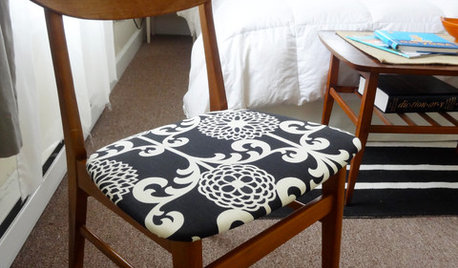Fireblock Foam Requirment for Wiring Through Drilled Holes?
Tom Pultz
14 years ago
Related Stories

MATERIALSInsulation Basics: What to Know About Spray Foam
Learn what exactly spray foam is, the pros and cons of using it and why you shouldn’t mess around with installation
Full Story
DIY PROJECTS29 Home Projects to Make You a DIY Superstar
Patch up holes, turn trash to treasure, erase stains ... these doable DIY projects will better your home and boost your ego
Full Story
DESIGN DICTIONARYConduit
A conduit inside a building serves as a channel for electrical cables and wires
Full Story0

HOUZZ TOURSMy Houzz: Art and Lucky Finds Fill an Airy New House
Bicycle wheels, wire hangers, IV drips ... anything can become furniture in this artistic family's home
Full Story
CONTRACTOR TIPSYour Complete Guide to Building Permits
Learn about permit requirements, the submittal process, final inspection and more
Full Story
GREEN BUILDINGInsulation Basics: Heat, R-Value and the Building Envelope
Learn how heat moves through a home and the materials that can stop it, to make sure your insulation is as effective as you think
Full Story
HOME OFFICESQuiet, Please! How to Cut Noise Pollution at Home
Leaf blowers, trucks or noisy neighbors driving you berserk? These sound-reduction strategies can help you hush things up
Full Story
BATHROOM DESIGNWater Damage Spawns a Space-Saving Bathroom Remodel
A game of inches saved this small New York City bathroom from becoming too cramped and limited
Full Story
BEDROOMSThe Right Mattress: The Secret to a Great Night’s Sleep
We spend a third of our lives asleep, so investing in a quality mattress is essential. Check out this expert advice to help you choose yours
Full Story
REMODELING GUIDESWisdom to Help Your Relationship Survive a Remodel
Spend less time patching up partnerships and more time spackling and sanding with this insight from a Houzz remodeling survey
Full StoryMore Discussions









hexus
countryboymo
Related Professionals
Aurora General Contractors · Bellingham General Contractors · Binghamton General Contractors · Klamath Falls General Contractors · Linton Hall General Contractors · Marietta General Contractors · Wheeling General Contractors · Woodland General Contractors · Saratoga Solar Energy Systems · South Whittier Home Automation & Home Media · Franklin Home Automation & Home Media · Hialeah Gardens Home Automation & Home Media · Los Angeles Home Automation & Home Media · Orange County Home Automation & Home Media · Saint Augustine Home Automation & Home MediaRon Natalie
Tom PultzOriginal Author
mrtimewise
abnorm
azlighting
fpeinok
Tom PultzOriginal Author